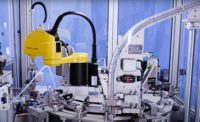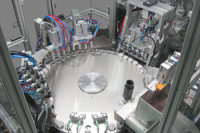Speed, precision and cleanliness are the hallmarks of automation for medical and pharmaceutical applications. A recent project designed and built by SP Automation and Robotics was no exception.
Based in Dundee, Scotland, SP Automation has been designing and manufacturing automated machinery for the medical device industry for more than 30 years. Last year, a pharmaceutical company contracted with SP Automation to design and build an automated system to automatically load, fill, cap and label vials of medication at a rate of 45 parts per minute. The system would need to be operate in a clean room environment.
SP Automation designed an eight-station rotary indexing system to do the job.
At the first station, a cobot picks up multiple glass vials from a tray and loads them onto the indexer. The guarding of the cobot area was zoned to allow for safe loading and unloading of trays without stopping the machine or production.
Next, the system records a tare weight for the vials. This is achieved by removing the vial from the dial plate and placing it onto an isolated weigh cell. Once the weight is recorded, the vial is placed back onto to dial plate.
The next stage was to fill the vial with the medication to an accuracy of ±3 microliters. Syringe pumps ensure a precise dosage. Once filled, the vial is indexed to the next station, where again it is removed and placed onto a scale to measure the filled weight. The controller subtracts the weight of the vial to determine how much medication was dispensed. The vial is then placed back into the dial plate and indexed to a capping station.
Caps are bowl-fed to an escapement, where they are picked up by a double-headed capping mechanism. While one half of the mechanism is screwing on a cap to a set torque, the other half is picking up the next cap. A vision system inspects the cap to ensure it’s at the correct height.
Vials that pass the weight and dimensional checks are off-loaded onto a conveyor and fed into an labeling system. The vial is conveyed on a free-rolling conveyor under a labeling head. A part-presence sensor triggers the labeling machine, and a uniquely printed label is applied and rolled around the vial.
Finished products then off-loaded and fed into a final packaging machine. Rejects (vials that were incorrectly filled or not properly capped) are removed and placed into a carousel to limit the chance of spillage.
An essential requirement of the system was the ability to handle product variants. Feed systems and tooling accommodate different sizes of the batched product with a maximum changeover time of five minutes.
For more information, call SP Automation at 01382-880088 or visit www.sp-automation.co.uk.



